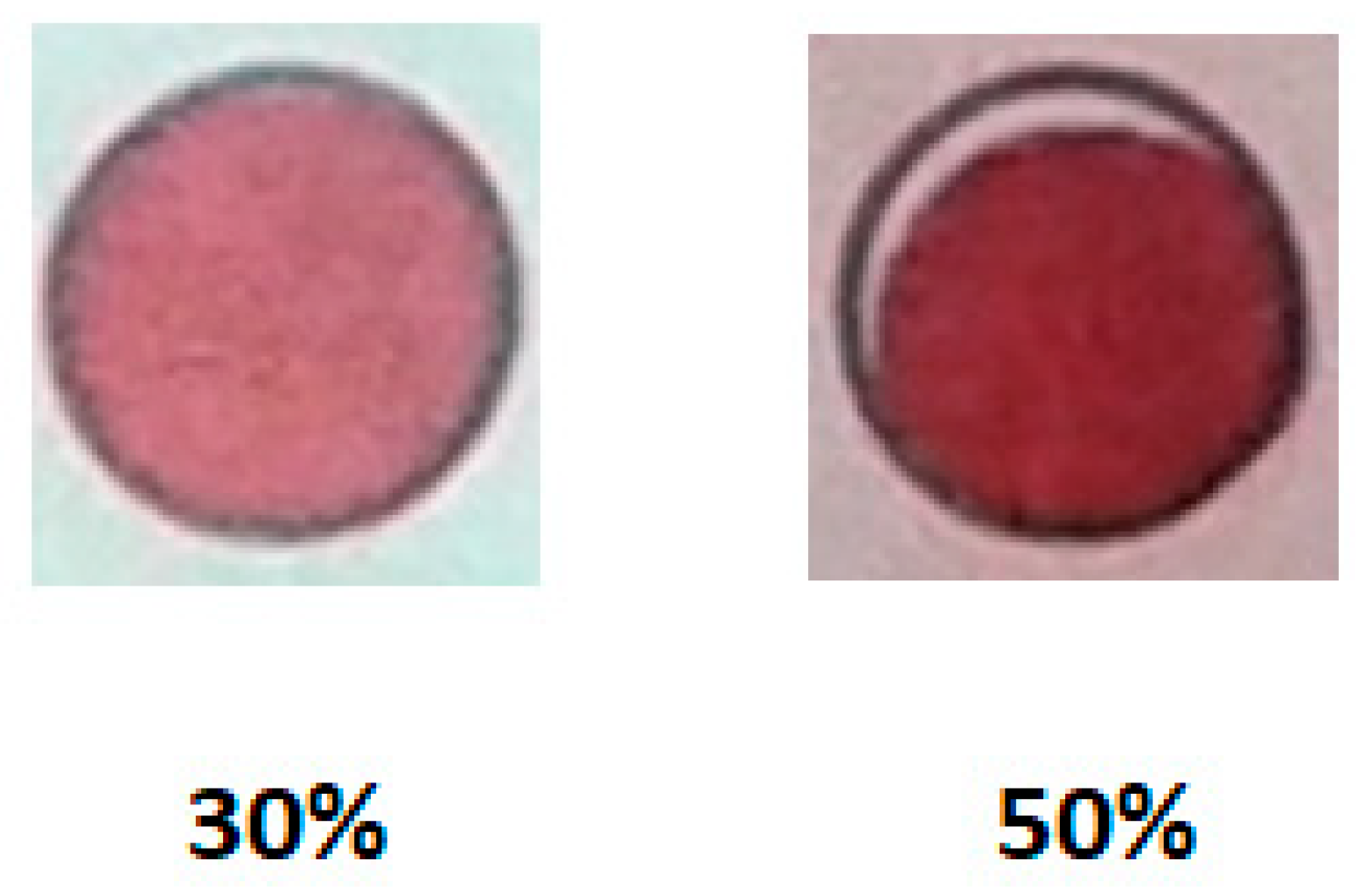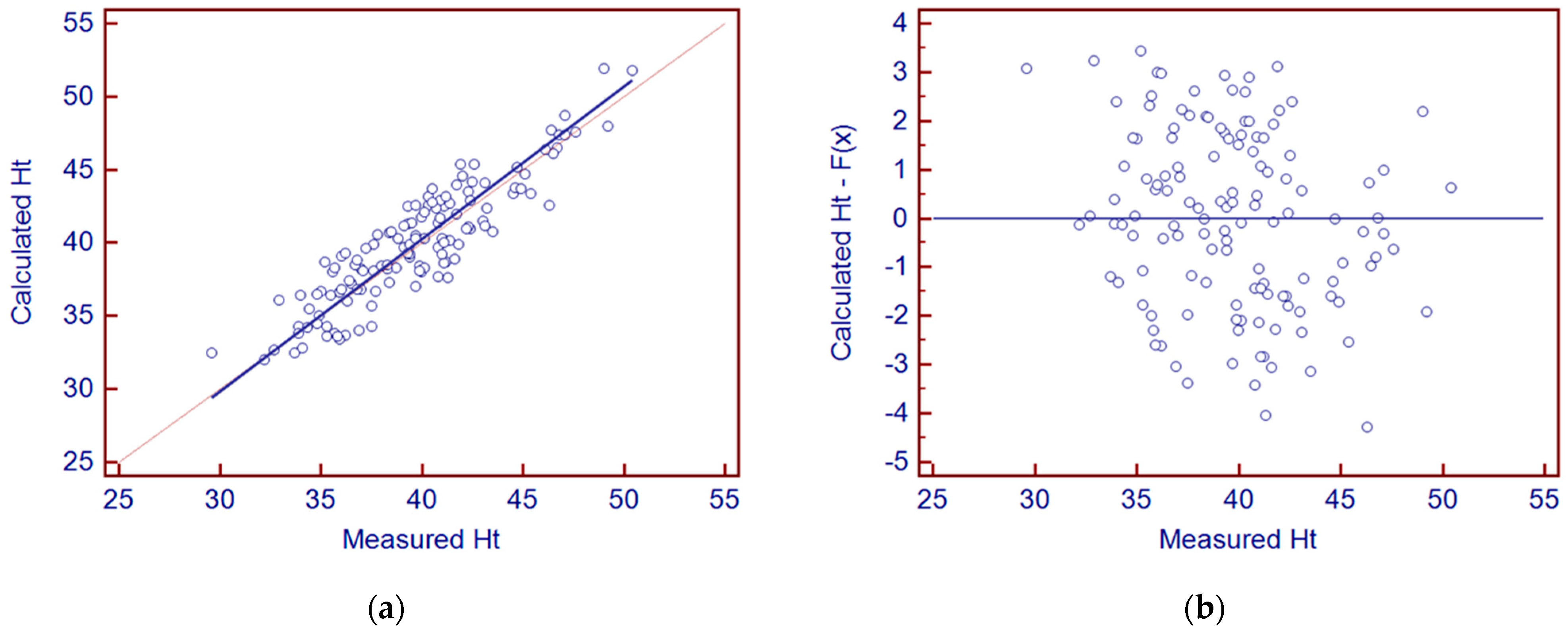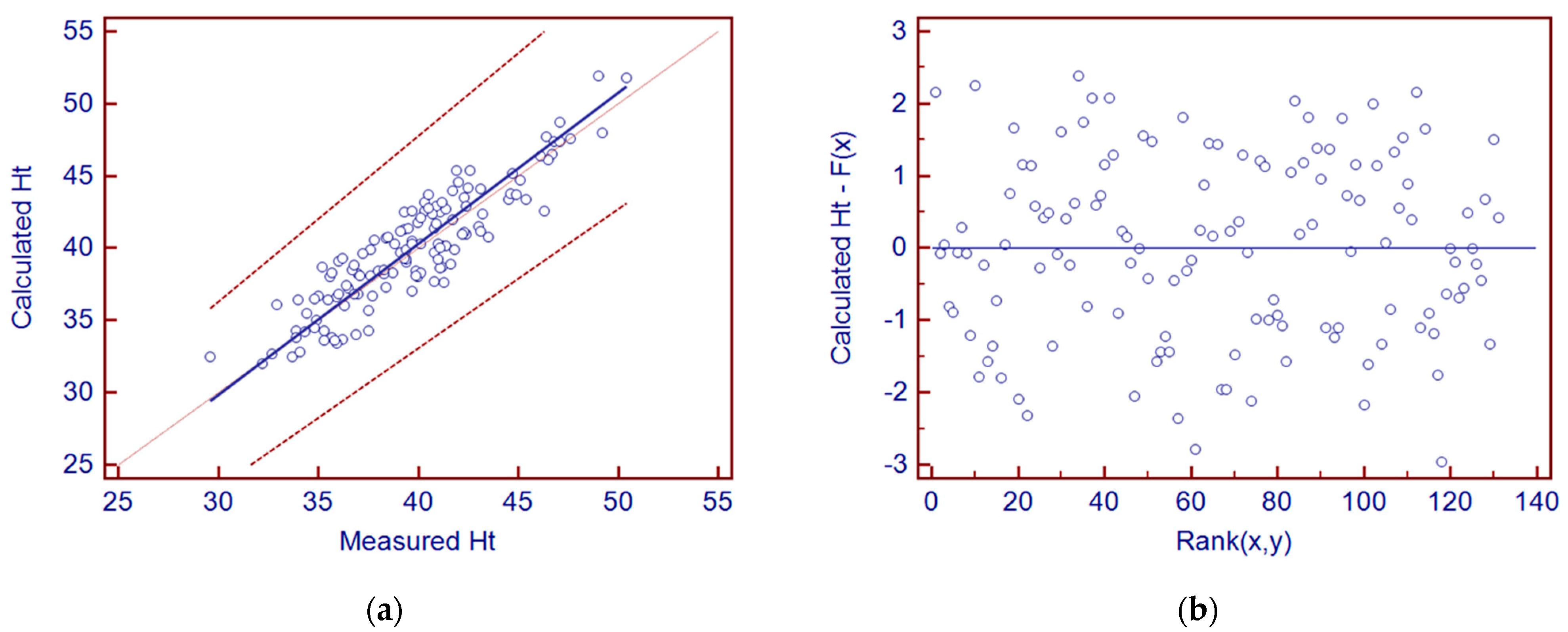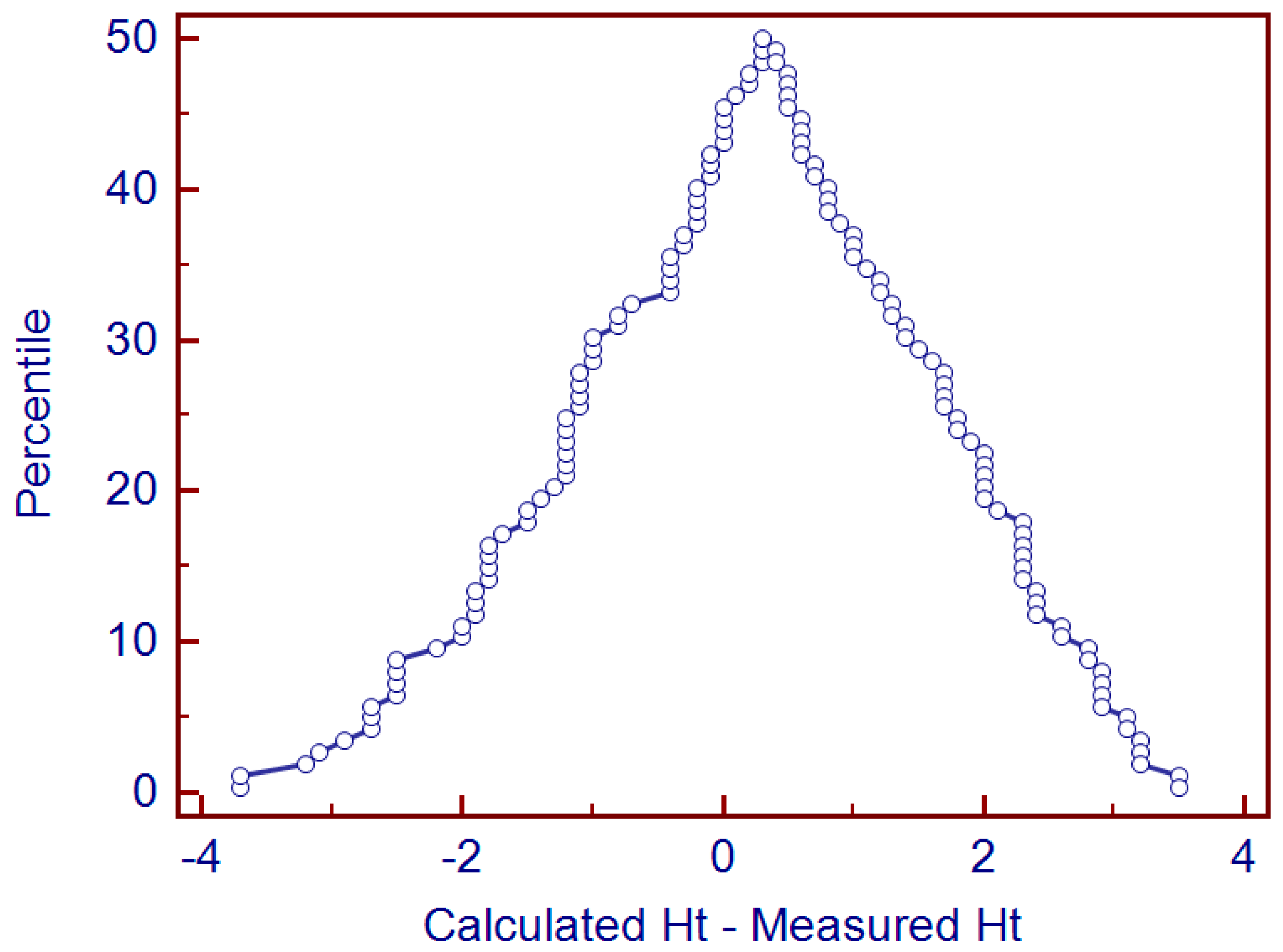On the Use of Image Analysis for Hematocrit Evaluation in Dried Blood Spots
Abstract
1. Introduction
2. Materials and Methods
2.1. Materials
2.2. DBS Preparation
2.3. Ht Measurement
2.4. Ht Estimation via Image Analysis
2.5. Statistical Comparison
3. Results
4. Discussion
5. Conclusions
Author Contributions
Funding
Institutional Review Board Statement
Informed Consent Statement
Data Availability Statement
Conflicts of Interest
Appendix A
References
- Guthrie, R.; Susi, A. A simple phenylalanine method for detecting phenylketonuria in large populations of newborn infants. Pediatrics 1963, 32, 338–343. [Google Scholar] [CrossRef] [PubMed]
- Chace, D.H. Mass spectrometry in newborn and metabolic screening: Historical perspective and future directions. J. Mass. Spectrom. 2009, 44, 163–170. [Google Scholar] [CrossRef] [PubMed]
- Wilhelm, A.J.; den Burger, J.C.G.; Swart, E.L. Therapeutic Drug Monitoring by Dried Blood Spot: Progress to date and future directions. Clin. Pharmacokinet. 2014, 53, 961–973. [Google Scholar] [CrossRef]
- Stove, C.P.; Ingels, A.S.; De Kesel, P.M.; Lambert, W.E. Dried blood spots in toxicology: From the cradle to the grave? Crit. Rev. Toxicol. 2012, 42, 230–243. [Google Scholar] [CrossRef]
- Spooner, N.; Lad, R.; Barfield, M. Dried blood spots as a sample collection technique for the determination of pharmacokinetics in clinical studies: Considerations for the validation of a quantitative bioanalytical method. Anal. Chem. 2009, 81, 1557–1563. [Google Scholar] [CrossRef]
- Patel, P.; Tanna, S.; Mulla, H.; Kairamkonda, V.; Pandya, H.; Lawson, G. Dexamethasone quantification in dried blood spot samples using LC-MS: The potential for application to neonatal pharmacokinetic studies. J. Chromatogr. B Anal. Technol. Biomed. Life Sci. 2010, 878, 3277–3282. [Google Scholar] [CrossRef]
- Sharma, A.; Jaiswal, S.; Shukla, M.; Lal, J. Dried blood spots: Concepts, present status, and future perspectives in bioanalysis. Drug Test Anal. 2014, 6, 399–414. [Google Scholar] [CrossRef]
- Denniff, P.; Spooner, N. The effect of hematocrit on assay bias when using DBS samples for the quantitative bioanalysis of drugs. Bioanalysis 2010, 2, 1385–1395. [Google Scholar] [CrossRef]
- O’Mara, M.; Hudson-Curtis, B.; Olson, K.; Yueh, Y.; Dunn, J.; Spooner, N. The effect of hematocrit and punch location on assay bias during quantitative bioanalysis of dried blood spot samples. Bioanalysis 2011, 3, 2335–2347. [Google Scholar] [CrossRef]
- De Kesel, P.M.; Sadones, N.; Capiau, S.; Lambert, W.E.; Stove, C.P. Hemato-critical issues in quantitative analysis of dried blood spots: Challenges and solutions. Bioanalysis 2013, 5, 2023–2041. [Google Scholar] [CrossRef]
- Beutler, E.; Waalen, J. The definition of anemia: What is the lower limit of normal of the blood hemoglobin concentration? Blood 2006, 107, 1747–1750. [Google Scholar] [CrossRef] [PubMed]
- Jager, N.G.L.; Rosing, H.; Schellens, J.H.; Beijnen, J.H. Procedures and practices for the validation of bioanalytical methods using dried blood spots: A review. Bioanalysis 2014, 6, 2481–2514. [Google Scholar] [CrossRef] [PubMed]
- ICH Guideline M10 on Bioanalytical Method Validation and Study Sample Analysis-Step 5 (EMA/CHMP/ICH/172948/2019). 2022. Available online: https://www.ema.europa.eu/en/ich-m10-bioanalytical-method-validation-scientific-guideline (accessed on 9 September 2024).
- Daousani, C.; Karalis, V.; Malenović, A.; Dotsikas, Y. Hematocrit effect on dried blood spots in adults: A computational study and theoretical considerations. Scand. J. Clin. Lab. Investig. 2019, 79, 325–333. [Google Scholar] [CrossRef]
- Capiau, S.; Veenhof, H.; Koster, R.A.; Bergqvist, Y.; Boettcher, M.; Halmingh, O.; Keevil, B.G.; Koch, B.D.P.; Linden, R.; Pistos, C.; et al. Official International Association for Therapeutic Drug Monitoring and Clinical Toxicology Guideline: Development and validation of Dried Blood Spot-based methods for Therapeutic Drug Monitoring. Ther. Drug Monit. 2019, 41, 409–430. [Google Scholar] [CrossRef]
- De Kesel, P.M.; Capiau, S.; Lambert, W.E.; Stove, C.P. Current strategies for coping with the hematocrit problem in dried blood spot analysis. Bioanalysis 2014, 6, 1871–1874. [Google Scholar] [CrossRef]
- Velghe, S.; Delahaye, L.; Stove, C.P. Is the hematocrit still an issue in quantitative dried blood spot analysis? J. Pharm. Biomed. Anal. 2019, 163, 188–196. [Google Scholar] [CrossRef]
- De Kesel, P.M.; Lambert, W.E.; Stove, C.P. Does volumetric absorptive microsampling eliminate the hematocrit bias for caffeine and paraxanthine in dried blood samples? A comparative study. Anal. Chim. Acta 2015, 881, 65–73. [Google Scholar] [CrossRef]
- Li, F.; Zulkoski, J.; Fast, D.; Michael, S. Perforated dried blood spots: A novel format for accurate microsampling. Bioanalysis 2011, 3, 2321–2333. [Google Scholar] [CrossRef]
- Leuthold, L.A.; Heudi, O.; Déglon, J.; Raccuglia, M.; Augsburger, M.; Picard, F.; Kretz, O.; Thomas, A. New microfluidic-based sampling procedure for overcoming the hematocrit problem associated with dried blood spot analysis. Anal. Chem. 2015, 87, 2068–2071. [Google Scholar] [CrossRef]
- Verplaetse, R.; Henion, J. Hematocrit-independent quantitation of stimulants in Dried Blood Spots: Pipet versus microfluidic-based volumetric sampling coupled with automated Flow-Through Desorption and Online Solid Phase Extraction-LC-MS/MS Bioanalysis. Anal. Chem. 2016, 88, 6789–6796. [Google Scholar] [CrossRef]
- Abu-Rabie, P.; Denniff, P.; Spooner, N.; Chowdhry, B.Z.; Pullen, F.S. Investigation of different approaches to incorporating internal standard in DBS quantitative bioanalytical workflows and their effect on nullifying hematocrit-based assay bias. Anal. Chem. 2015, 87, 4996–5003. [Google Scholar] [CrossRef] [PubMed]
- Cao, H.; Jiang, Y.; Wang, S.; Cao, H.; Li, Y.; Huang, J. Dried Plasma Spot Based LC-MS/MS Method for Monitoring of Meropenem in the Blood of Treated Patients. Molecules 2022, 27, 1991. [Google Scholar] [CrossRef] [PubMed]
- Lombardi, V.; Carassiti, D.; Giovannoni, G.; Lu, C.-H.; Adiutori, R.; Malaspina, A. The potential of neurofilaments analysis using dry-blood and plasma spots. Sci. Rep. 2020, 10, 97. [Google Scholar] [CrossRef]
- Nakahara, T.; Otani, N.; Ueno, T.; Hashimoto, K. Development of a hematocrit-insensitive device to collect accurate volumes of dried blood spots without specialized skills for measuring clozapine and its metabolites as model analytes. J. Chromatogr. B 2018, 1087–1088, 70–79. [Google Scholar] [CrossRef]
- Capiau, S.; Stove, V.V.; Lambert, W.E.; Stove, C.P. Prediction of the hematocrit of dried blood spots via potassium measurement on a routine clinical chemistry analyser. Anal. Chem. 2013, 85, 404–410. [Google Scholar] [CrossRef]
- De Kesel, P.M.; Capiau, S.; Stove, V.V.; Lambert, W.E.; Stove, C.P. Potassium-based algorithm allows correction for the hematocrit bias in quantitative analysis of caffeine and its major metabolite in dried blood spots. Anal. Bioanal. Chem. 2014, 406, 749–755. [Google Scholar] [CrossRef]
- Liao, H.-W.; Lin, S.-W.; Lin, Y.-T.; Lee, C.-H.; Kuo, C.-H. Identification of potential sphingomyelin markers for the estimation of hematocrit in dried blood spots via a lipidomic strategy. Anal. Chim. Acta 2018, 1003, 34–41. [Google Scholar] [CrossRef]
- Richardson, G.; Marshall, D.; Keevil, B.G. Prediction of haematocrit in dried blood spots from the measurement of haemoglobin using commercially available sodium lauryl sulphate. Ann. Clin. Biochem. 2018, 55, 363–367. [Google Scholar] [CrossRef]
- Delahaye, L.; Heughebaert, L.; Lühr, C.; Lambrecht, S.; Stove, C.P. Near-infrared-based hematocrit prediction of dried blood spots: An in-depth evaluation. Clin. Chim. Acta 2021, 523, 239–246. [Google Scholar] [CrossRef]
- Capiau, S.; Wilk, L.S.; De Kesel, P.M.; Aalders, M.C.G.; Stove, C.P. Correction for the Hematocrit bias in Dried Blood Spot analysis using a nondestructive, single-wavelength reflectance-based Hematocrit prediction method. Anal. Chem. 2018, 90, 1795–1804. [Google Scholar] [CrossRef]
- Foivas, A.; Malenović, A.; Kostić, N.; Božić, M.; Knežević, M.; Loukas, Y.L.; Dotsikas, Y. Quantitation of brinzolamide in dried blood spots by a novel LC-QTOF-MS/MS method. J. Pharm. Biomed. Anal. 2016, 119, 84–90. [Google Scholar] [CrossRef] [PubMed]
- Daousani, C.; Karalis, V.; Loukas, Y.L.; Schulpis, K.H.; Alexiou, K.; Dotsikas, Y. Dried Blood Spots in Neonatal Studies: A Computational Analysis for the Role of the Hematocrit Effect. Pharmaceuticals 2023, 16, 1126. [Google Scholar] [CrossRef] [PubMed]
- MedCalc Statistical Software, Version 23.0.1; MedCalc Software bv: Ostend, Belgium, 2023. Available online: https://www.medcalc.org (accessed on 15 May 2024).
- Kostić, N.; Dotsikas, Y.; Jović, N.; Stevanović, G.; Malenović, A.; Medenica, M. Quantitation of pregabalin in dried blood spots and dried plasma spots by validated LC-MS/MS methods. J. Pharm. Biomed. Anal. 2015, 10, 79–84. [Google Scholar] [CrossRef]
- Bland, J.M.; Altman, D.G. Statistical methods for assessing agreement between two methods of clinical measurement. Lancet 1986, 1, 307–310. [Google Scholar] [CrossRef]
- Cornbleet, P.J.; Gochman, N. Incorrect least-squares regression coefficients in method-comparison analysis. Clin. Chem. 1979, 25, 432–438. [Google Scholar] [CrossRef]
- Passing, H.; Bablok, W. A new biometrical procedure for testing the equality of measurements from two different analytical methods. Application of linear regression procedures for method comparison studies in clinical chemistry, Part I. J. Clin. Chem. Clin. Biochem. 1983, 21, 709–720. [Google Scholar] [CrossRef]
- Passing, H.; Bablok, W. Comparison of several regression procedures for method comparison studies and determination of sample sizes. Application of linear regression procedures for method comparison studies in Clinical Chemistry, Part II. J. Clin. Chem. Clin. Biochem. 1984, 22, 431–445. [Google Scholar] [CrossRef]
- Krouwer, J.S.; Monti, K.L. A simple, graphical method to evaluate laboratory assays. Eur. J. Clin. Chem. Clin. Biochem. 1995, 33, 525–527. [Google Scholar]
- Rmandić, M.; Dotsikas, Y.; Malenović, A. Identification of the factors affecting the consistency of DBS formation via experimental design and image processing methodology. Microchem. J. 2019, 145, 1003–1010. [Google Scholar] [CrossRef]
- Stammers, A.H.; Vang, S.N.; Mejak, B.L.; Rauch, E.D. Quantification of the effect of altering hematocrit and temperature on blood viscosity. J. Extra Corpor. Technol. 2003, 35, 143–151. [Google Scholar] [CrossRef]





| Formula | Details |
|---|---|
| y = −0.0070x + 1.32 (R2 = 0.984) | y: area (cm2), Paper: Whatman 903™, Blood volume: 50 μL |
| Sample 1 (Calculated Ht) | Sample 2 (Measured Ht) | |
|---|---|---|
| Sample size | 131 | 131 |
| Arithmetic mean | 39.9443 | 39.6733 |
| 95% Confidence interval (CI) for the mean | 39.2385 to 40.6501 | 38.9956 to 40.3510 |
| Variance | 16.6739 | 15.3718 |
| Standard deviation (SD) | 4.0834 | 3.9207 |
| Standard error of the mean | 0.3568 | 0.3426 |
| Mean difference | −0.2710 | |
| SD of mean difference | 1.7936 | |
| Standard error of mean difference | 0.1567 | |
| 95% CI | −0.5810 to 0.03903 | |
| Test statistic t | −1.729 | |
| Degrees of freedom (DFs) | 130 | |
| Two-tailed probability | p = 0.0861 | |
| Systematic differences | |
| Intercept A | −1.6532 |
| 95% CI | −5.5200 to 1.7893 |
| Proportional differences | |
| Slope B | 1.0484 |
| 95% CI | 0.9643 to 1.1500 |
| Random differences | |
| Residual standard deviation (RSD) | 1.2674 |
| ±1.96 RSD Interval | −2.4840 to 2.4840 |
| Linear model validity | |
| Cusum test for linearity | No significant deviation from linearity (p = 0.55) |
Disclaimer/Publisher’s Note: The statements, opinions and data contained in all publications are solely those of the individual author(s) and contributor(s) and not of MDPI and/or the editor(s). MDPI and/or the editor(s) disclaim responsibility for any injury to people or property resulting from any ideas, methods, instructions or products referred to in the content. |
© 2024 by the authors. Licensee MDPI, Basel, Switzerland. This article is an open access article distributed under the terms and conditions of the Creative Commons Attribution (CC BY) license (https://creativecommons.org/licenses/by/4.0/).
Share and Cite
Daousani, C.; Kostić, N.; Malenović, A.; Rmandić, M.; Dotsikas, Y. On the Use of Image Analysis for Hematocrit Evaluation in Dried Blood Spots. Appl. Sci. 2024, 14, 9860. https://doi.org/10.3390/app14219860
Daousani C, Kostić N, Malenović A, Rmandić M, Dotsikas Y. On the Use of Image Analysis for Hematocrit Evaluation in Dried Blood Spots. Applied Sciences. 2024; 14(21):9860. https://doi.org/10.3390/app14219860
Chicago/Turabian StyleDaousani, Chrysa, Nađa Kostić, Anđelija Malenović, Milena Rmandić, and Yannis Dotsikas. 2024. "On the Use of Image Analysis for Hematocrit Evaluation in Dried Blood Spots" Applied Sciences 14, no. 21: 9860. https://doi.org/10.3390/app14219860
APA StyleDaousani, C., Kostić, N., Malenović, A., Rmandić, M., & Dotsikas, Y. (2024). On the Use of Image Analysis for Hematocrit Evaluation in Dried Blood Spots. Applied Sciences, 14(21), 9860. https://doi.org/10.3390/app14219860







